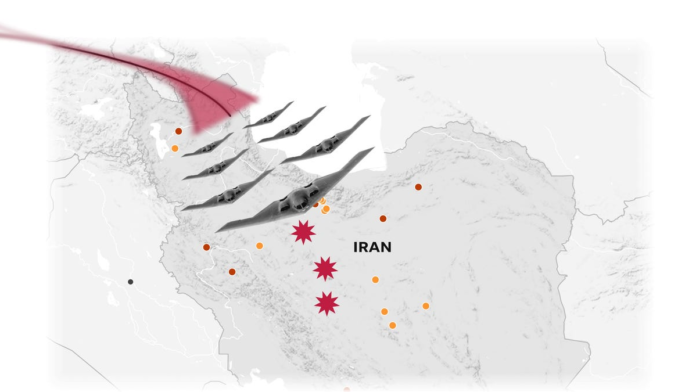Why invest in the U.S. Air Force? Look at the Ukraine-Russia war. The fact that neither side has air superiority is a significant contributing factor to the stalemate and death toll.

Senators privately briefied on US strikes on Iran’s nuclear facilities
Trump officials gave senators a classified briefing on the U.S. strikes on Iran’s nuclear facilities.
The world recently witnessed a visceral demonstration of technological prowess, skill and courage when the U.S. Air Force dropped GBU-57 massive ordnance bombs within inches of their aiming points on Iranian nuclear facilities.
As unquestionably successful as the mission was, we must be clear-eyed in how we view the implications. Our B-2 bombers, along with other aircraft, flew deep into Iranian territory without resistance. After suppressing surface-to-air threats ahead of the strike, not a single shot was fired against any of the aircraft as they operated in another country’s airspace.
In modern wars against adversaries such as China, we know the threat will be much different. In those cases, we know there is no guarantee of the “air superiority” our crews experienced during Operation Midnight Hammer without significant investment in air power.
To understand what it means, and why every American should care, turn your attention to Ukraine, where neither Ukraine nor Russia has superiority in the air. When juxtaposed against the backdrop of the war in Ukraine, the Iranian strike offers an important lesson for national leaders: We never want to fight without air superiority.
Despite 1.4 million casualties, Ukraine-Russia war is a stalemate
The 3-year-old conflict in Ukraine has settled into a brutal slog as the two nations measure success in incremental gains on the ground and by the unfortunate data point associated with the worst part of war ‒ casualties, both military and civilian. Russia and Ukraine have failed to turn any territorial gain into a strategic victory despite a death and casualty rate approaching 1 million for the Russian military and 400,000 for Ukraine.
The fact that neither side has air superiority is a significant contributing factor to the stalemate and death toll.
For the United States, by contrast, almost every theory of prevailing in conflict, no matter the circumstance or scale, starts with having – and holding – absolute or near-absolute air superiority.
Our ability to fly around the globe, enter enemy airspace with multiple aircraft, precisely strike multiple targets and return home without injury to American personnel exists because of air superiority.
However, the ability to maintain this condition over a battlefield comes at substantial cost. Built into the cost is the reality that every nation understands how essential air superiority is, which is why ensuring that the United States achieves it and holds it has never been more difficult.
US aircraft fleet is the smallest and oldest it’s ever been
The technology associated with the B-2 stealth bomber is over 30 years old, and we are only able to maintain a fleet of 19 of them due to their cost.
A strike like the one against Iran would be hard if not impossible to repeat at scale in a larger campaign, or in a fight against any of our peer or near-peer competitors. Victory would almost assuredly require multiple strike packages.
Equally important is this: Technology alone is not a guarantor of success. The men and women who carried out the strike in Iran are the best trained pilots on earth. They don’t get to be the best without exquisite training that includes thousands of hours in both advanced simulators and actual aircraft. Those flight hours require fuel, wear and tear on the aircraft, proven instructors and time. Technology without investment in training will nullify the advantage that tech offers.
For America to truly take advantage of its hard-earned advantages in technology and training, the Air Force must also recruit the best and brightest our nation has to offer. This isn’t just about coming up with trendy slogans that catch the eyes and ears of would-be aviators; it’s much harder than that.
It’s a large organization communicating its value proposition to smart, young Americans who have career options in a competitive job market. We must continue to invest to create a quality of life that inspires those aviators, as well as their families, to continue to serve ‒ not only because it’s smart human resourcing, but also because it’s the right thing to do for these patriots.
We want and need patriots, but patriotism alone will not earn us control of the skies.
The Air Force, like our fellow military services, needs sufficient funding. Without enough dollars, the best people and aircraft are not enough.
Unfortunately, the Air Force has been underfunded for decades. The aircraft fleet is the smallest and oldest it’s ever been. This status raises obvious – and ominous ‒ questions as to whether air superiority is achievable against an advanced, determined adversary.
Again, we would be wise to pay close attention to Ukraine and the horrific number of casualties in that war to get an idea of the result if the advantage the United States has historically held in the air begins to shrink.
The latest budget released by the White House recognizes the need. It includes investment in the F-47, the Air Force’s first sixth generation fighter, among other Air Force critical funding initiatives, all of which contribute to maintaining dominance in the sky.
These investments are necessary even at a time of difficult budget choices. To maintain global peace and stability, the Air Force needs to own the skies in a manner that our adversaries understand ‒ like we did in Iran but against much tougher opposition. That is the foundation of deterrence. It is the operational centerpiece of a military service designed to give the president valid and credible options for any circumstance.
The cost is high, but so are the risks if we fail. The war in Ukraine highlights this truth every day in a vivid way that is impossible to ignore. Brig. Gen. Allen Herritage is the director of public affairs for the Air Force and Space Force.


























